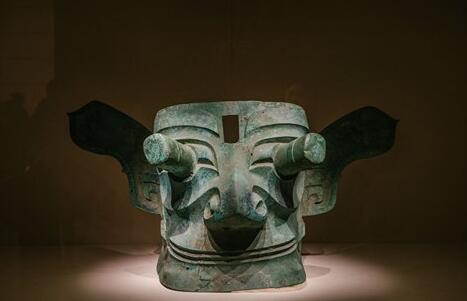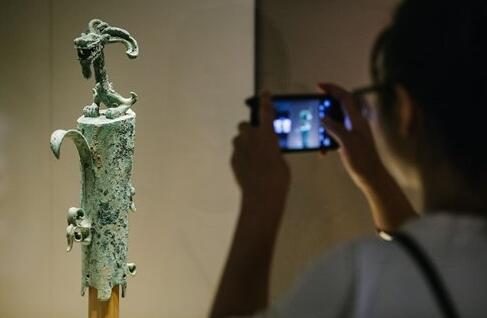New National Museum of China exhibition delves into the culture of the ancient Shu Kingdom
Sichuan, a province in Southwest China, has long been famous for its rich history and large variety of cultural relics that reflect local customs and beliefs dating back to around 3,000 years ago.
Going back to its beginnings, the region of what is now western Sichuan was once the center of what was known as the Kingdom of Shu (Unknown - 316 BC). To introduce the brilliant history of this region to the general public, an exhibition featuring a selection of ancient Shu cultural relics from Sichuan kicked off at the National Museum of China in Beijing on Thursday.
The exhibition is arranged in chronological order with five main sections laying out the history of this mysterious ancient kingdom and the connected Sanxingdui, Shierqiao and Qingyanggong cultures.

A bronze head discovered at the Sanxingdui site in Sichuan Province Photo: Li Hao/GT
Early Shu culture
Following a preliminary discovery in 1929, Sanxingdui was systematically excavated starting in 1986. The findings, which cover a period of time ranging from the 18th century BC to the mid-12th century BC, have given archaeologists an excellent window into the early development of Shu culture.
The Sanxingdui site was the early capital of the Shu Kingdom as well as its "cultural center," Guo Juntao, the curator of the Sichuan Museum, said at a media conference for the exhibition on Thursday.
The most outstanding finds unearthed at the site were two treasure pits containing more than 1,700 cultural relics in total, including bronze sculptures, bronze pommels and jades. Adding to the historical value of these finds is that the styles of the artifacts are very different from those found in other sites across China dating from the same period.
According to Guo, the majority of the Sanxingdui culture relics on display were selected from the two treasure pits.
"The huge bronze face you see upon first entering the exhibition is the most representative item of Sanxingdui culture," Guo noted, referring to a large bronze head with long protruding eyes.
"According to historical documents, this bronze face might be a reflection of the vague memories they had about the ancestor of the ancient Shu people. They heard legendary stories about their great ancestor and made this bronze face so they could pray to their ancestor."
The second section delves into the Shierqiao culture that existed between the 12th century BC and the 6th century BC. During this time, the capital of the Shu Kingdom moved from the Sanxingdui area to an area 50 kilometers away near where modern Chengdu, the capital city of Sichuan Province, is located. The remains of this capital was discovered in what is now known as the Jinsha site.
"We found bronze pommels similar to those we found in Sanxingdui. However, we have no evidence that helps us determine what their function was. Most likely they were symbols of power," Huang Yi, curator of the National Museum of China, explained.

A bronze pommel Photo: Li Hao/GT
Late Shu culture
"Many visitors may be familiar with the Sanxingdui and Jinsha archaeological sites, but few have heard about the late Shu culture," Guo explained.
Late Shu culture, which refers to Sichuan culture after the 4th century BC, often gets overlooked compared to the earlier Sanxingdui and Shierqiao cultures due to the fact that the Shu Kingdom was conquered by the Qin Dynasty (206BC-220AD) in 316 BC. After its unification into the Qin Dynasty, Shu culture began fusing with other cultures from the central plains of China.
However, some important discoveries dating from this period have been unearthed.
In 1980, a huge tomb was discovered in Majiaxiang, Xindu county in Sichuan Province. Dating to the Warring States period (475BC-221BC), the tomb contained more than 200 bronze wares. According to experts, the luxury burial objects indicate that the tomb owner was "possibly the king of the Shu."
The exhibition is set to come to an end on September 19, after which it will head to South China's Guangdong Province and then on to Italy in December.

